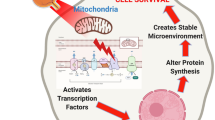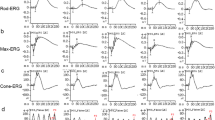Abstract
To assess the safety and to quantify the effects of a single application of all-trans-N-retinylacetamide on the rat retina measured by electroretinography (ERG). Brown Norway rats were assigned to either a control group (n = 13) or to one of the three groups treated with a single intra-peritoneal dose of all-trans-N-retinylacetamide: 20 (n = 8), 5 (n = 7), or 1 mg/kg (n = 8). Full-field ERGs were performed 7 days before (baseline) and 12 h after treatment. Intensity–response relationship of b-wave amplitudes were evaluated in dark-adapted conditions using white stimuli (0.000003–0.3 cd.s/m2). Fast dynamics of rod sensitivity was assessed by a paired-flash paradigm; recovery dynamics of b-wave amplitudes after bleaching was followed for 70 min. Light-adapted ERGs were recorded for cone evaluation. No effects were found on either dark-adapted sensitivity or on fast rod recovery. However, drug treatment at 5 and 20 mg/kg significantly delayed ERG amplitude recovery after bleaching: 60 min after bleaching the b-wave amplitude was 21 ± 9% (P < 0.05) and 66 ± 10% (P < 0.05), respectively, compared to baseline. Recovery rates returned to normal 8 weeks after treatment. There were no changes in light-adapted ERG in any group. Systemic administration of a single dose of the visual cycle modulator all-trans-N-retinylacetamide reversibly delayed recovery of dark-adapted ERG amplitudes after bleaching, leaving other functions unchanged. This finding could make the compound potentially useful in experimental conditions or in specific diseases where the visual cycle is involved, such as retinitis pigmentosa or age-related macular degeneration.







Similar content being viewed by others
References
Lamb TD, Pugh EN Jr (2004) Dark adaptation and the retinoid cycle of vision. Prog Retin Eye Res 23:307–380
Sparrow JR, Fishkin N, Zhou J, Cai B, Jang YP, Krane S, Itagaki Y, Nakanishi K (2003) A2E, a byproduct of the visual cycle. Vision Res 43:2983–2990
Eldred GE, Lasky MR (1993) Retinal age pigments generated by self-assembling lysosomotropic detergents. Nature 361:724–726
Delori FC, Staurenghi G, Arend O, Dorey CK, Goger DG, Weiter JJ (1995) In vivo measurement of lipofuscin in Stargardt’s disease–Fundus flavimaculatus. Invest Ophthalmol Vis Sci 36:2327–2331
Katz ML (2002) Potential role of retinal pigment epithelial lipofuscin accumulation in age-related macular degeneration. Arch Gerontol Geriatr 34:359–370
Golczak M, Kuksa V, Maeda T, Moise AR, Palczewski K (2005) Positively charged retinoids are potent and selective inhibitors of the trans–cis isomerization in the retinoid (visual) cycle. Proc Natl Acad Sci U S A 102:8162–8167
Maeda A, Maeda T, Golczak M, Imanishi Y, Leahy P, Kubota R, Palczewski K (2006) Effects of potent inhibitors of the retinoid cycle on visual function and photoreceptor protection from light damage in mice. Mol Pharmacol 70:1220–1229
Golczak M, Maeda A, Bereta G, Maeda T, Kiser PD, Hunzelmann S, von Lintig J, Blaner WS, Palczewski K (2008) Metabolic basis of visual cycle inhibition by retinoid and nonretinoid compounds in the vertebrate retina. J Biol Chem 283:9543–9554
Lyubarsky AL, Daniele LL, Pugh EN Jr (2004) From candelas to photoisomerizations in the mouse eye by rhodopsin bleaching in situ and the light-rearing dependence of the major components of the mouse ERG. Vision Res 44:3235–3251
Messias A, Jaegle H, Gekeler F, Zrenner E (2008) Software for evaluation of electroretinograms XLVI annual symposium of the international society for clinical electrophysiology of vision (ISCEV), Morgantown, USA
Evans LS, Peachey NS, Marchese AL (1993) Comparison of three methods of estimating the parameters of the Naka-Rushton equation. Doc Ophthalmol 84:19–30
Radu RA, Mata NL, Nusinowitz S, Liu X, Sieving PA, Travis GH (2003) Treatment with isotretinoin inhibits lipofuscin accumulation in a mouse model of recessive Stargardt’s macular degeneration. Proc Natl Acad Sci U S A 100:4742–4747
Allikmets R, Singh N, Sun H, Shroyer NF, Hutchinson A, Chidambaram A, Gerrard B, Baird L, Stauffer D, Peiffer A, Rattner A, Smallwood P, Li Y, Anderson KL, Lewis RA, Nathans J, Leppert M, Dean M, Lupski JR (1997) A photoreceptor cell-specific ATP-binding transporter gene (ABCR) is mutated in recessive Stargardt macular dystrophy. Nat Genet 15:236–246
Klevering BJ, Yzer S, Rohrschneider K, Zonneveld M, Allikmets R, van den Born LI, Maugeri A, Hoyng CB, Cremers FP (2004) Microarray-based mutation analysis of the ABCA4 (ABCR) gene in autosomal recessive cone-rod dystrophy and retinitis pigmentosa. Eur J Hum Genet 12:1024–1032
Holz FG, Bellman C, Staudt S, Schutt F, Volcker HE (2001) Fundus autofluorescence and development of geographic atrophy in age-related macular degeneration. Invest Ophthalmol Vis Sci 42:1051–1056
Schmitz-Valckenberg S, Fleckenstein M, Scholl HP, Holz FG (2009) Fundus autofluorescence and progression of age-related macular degeneration. Surv Ophthalmol 54:96–117
Travis GH, Golczak M, Moise AR, Palczewski K (2007) Diseases caused by defects in the visual cycle: retinoids as potential therapeutic agents. Annu Rev Pharmacol Toxicol 47:469–512
Hanein S, Perrault I, Gerber S, Tanguy G, Rozet JM, Kaplan J (2006) Leber congenital amaurosis: survey of the genetic heterogeneity, refinement of the clinical definition and phenotype-genotype correlations as a strategy for molecular diagnosis. Clinical and molecular survey in LCA. Adv Exp Med Biol 572:15–20
Lim JI, Walonker AF, Levin L, Mahmoud M, Sadda S, Flaxel CJ, Humayun M, de Juan Labree L E, Labree L (2006) One-year results of a pilot study using oral 13-cis retinoic acid as a treatment for subfoveal predominantly occult choroidal neovascularization in patients with age-related macular degeneration. Retina 26:314–321
Author information
Authors and Affiliations
Corresponding author
Additional information
Andre Messias and Eberhart Zrenner have equally contributed to this work.
Rights and permissions
About this article
Cite this article
Messias, A., Zrenner, E., Tzekov, R. et al. Single doses of all-trans-N-retinylacetamide slow down the ERG amplitude recovery after bleaching in rats. Doc Ophthalmol 120, 165–174 (2010). https://doi.org/10.1007/s10633-009-9209-2
Received:
Accepted:
Published:
Issue Date:
DOI: https://doi.org/10.1007/s10633-009-9209-2




